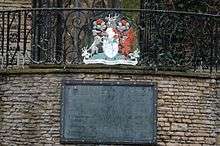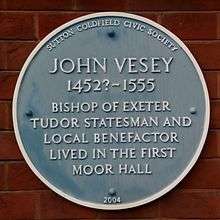John Vesey
John Vesey or Veysey (1462?–1554) was an English bishop.

Life
Veysey was born John Harman, probably about 1462, the son of a yeoman farmer, in a farmhouse which still exists near the site of Moor Hall, Sutton Coldfield. He received his education at Magdalen College, Oxford, where he gained a doctorate in canon and civil law.[1] After ordination he was appointed rector of St Mary's Church, Chester. He founded Bishop Veysey's Grammar School for boys in Sutton Coldfield in 1527, which is named after him to this day.
Veysey became a friend of Thomas Wolsey who was also educated at Magdalen College. From some unknown date until 1508 Veysey served as Archdeacon of Barnstaple. In 1509, Wolsey became a canon of Windsor and chaplain to Henry VIII of England. Veysey was appointed a canon of Exeter Cathedral. Veysey became the Bishop of Exeter in 1519 and the King awarded him the temporalities of the see, worth about £1,500 a year. He was consecrated a bishop on 6 November 1519, by William Warham, Archbishop of Canterbury, assisted by John Fisher, Bishop of Rochester, and Thomas Halsey, suffragan of York and Bishop of Leighlin.[2] The town of his birth benefited greatly from his wealth. In 1527 he obtained permission to enclose a large plot of land close to his birthplace and built a grand house (as of 2013 the site of Moor Hall Hotel) where he occasionally lived.
The township of Sutton Coldfield had fallen on hard times and Veysey took it on himself to restore the fortunes of the town and its inhabitants. He prevailed upon the King to grant a Royal Charter of incorporation for the town in 1528; this entrusted the government of the town to a warden and to 24 local inhabitants known together as the Warden and Society of the Royal Town of Sutton Coldfield.
Veysey is credited by the historian James Norris Brewer with rebuilding the aisles of the church, reviving the markets and building a marketplace, paving the town, building two stone bridges, founding and endowing a free grammar school, Bishop Veysey's Grammar School, and building 51 stone houses (at least four of which survive).[3]
Veysey survived the fall of Wolsey in 1529 and prospered reasonably under Thomas Cromwell until 1551, when his opposition to the English Reformation caught up with him. He was deprived of his see by Edward VI[4] and its temporalities in exchange for a pension of £485 a year. He was restored to the see of Exeter when Queen Mary came to the throne in 1553. He died in 1554 and was buried at Holy Trinity Church on Trinity Hill, Sutton Coldfield, which the school visits annually in a ceremony. His tomb is located within the church.[5]
Sutton Coldfield was granted the Royal Tudor Rose by King Henry VIII in thanks for being aided by a young woman who shot dead, with an arrow, a wild boar which was charging at the King in 1528. He asked for the person responsible to come forward and a young woman from Sutton Coldfield came out of the trees. Vesey, a close friend of the King, was present at the incident.[6] They also returned dispossessed land to the young woman's family.[7]
References
- Alumni Oxonienses 1500-1714, Haak-Harman
- Perceval, Arthur Philip. An Apology for the Doctrine of Apostolical Succession: With an Appendix, on the English Orders. second edition (London: Rivington, 1841) p. 188.
- Brewer, James Norris (1820). A topographical and historical description of the county of Warwick. pp. 296–299.
- de3 Thoyras, Rapin (1747). An abridgement of the history of England: being a summary of Mr. Rapin's history and Mr. Tindal's continuation : From the landing of Julius Caesar to the death of king George I.
- Birmingham.gov.uk: Bishop Vesey's Monument Archived 10 June 2008 at the Wayback Machine
- Weir, Alison (2011). Henry VIII: King and Court. Random House. p. 287. ISBN 9781446449233.
- "The Past – Sutton Coldfield's History". Sutton Coldfield. Retrieved 18 July 2016.
Sources
- George Oliver, The Lives of the Bishops of Exeter, 1861.
- Fryer, Geoffrey R.D. (1997), John Veysey and His World: A Biography of Bishop Veysey (c.1465–1554) of Sutton Coldfield: published by the author. ISBN 0-9682625-0-3.
External links
| Religious titles | ||
|---|---|---|
| Preceded by Hugh Oldham |
Bishop of Exeter 1519–1551 |
Succeeded by Myles Coverdale |
| Preceded by Myles Coverdale |
Bishop of Exeter 1553–1554 |
Succeeded by James Turberville |
